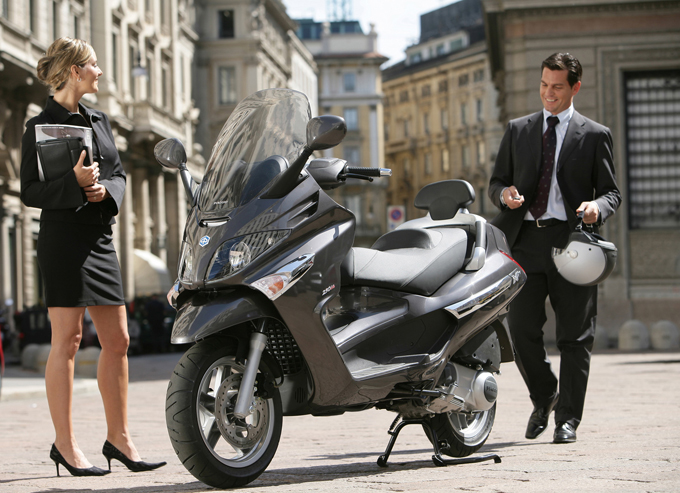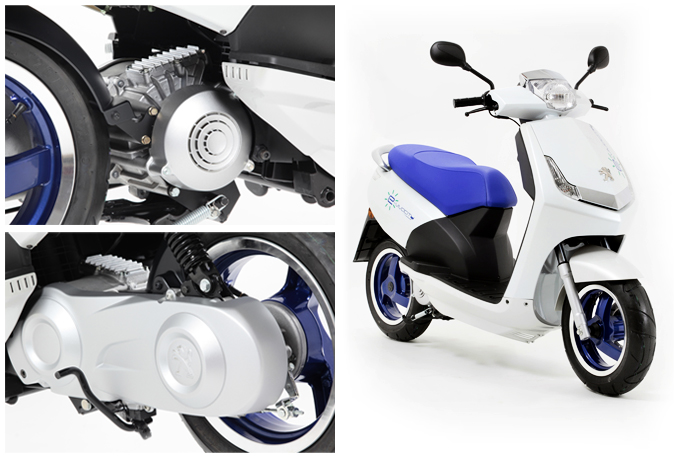PTW Sales Fall in the EU: ACEM
2011/09/15 | By Quincy LiangEurope has always been one of the most important areas for the global powered two-wheeler (PTW) industry. The region represents an annual market of two million to 2.5 million PTWs, and the greatest majority of international PTW brands are based on the continent.
In the first two quarters of the year, some key developments in Europe are expected to help global PTW-related makers and buyers plan sales and purchase policies ahead of the second half, as well as recognize more or less the overall development trends in the industry.
Sales Down
Sales of new powered two-wheelers (PTWs) in European Union (EU) nations have been trending clearly down over the past two or three years following the global financial crisis starting in 2008. In the first quarter of this year, however, the trend saw signs of recovery, according to the Association of Motorcycle Manufacturers in Europe (ACEM).

Historically known for being a peak season for PTW sales in Europe, spring is leaving manufacturers for the third consecutive year without the expected rebound from the financial crisis, the makers' association said.
The crisis is not over yet for the European motorcycle sector. The latest figures for the spring sales and registrations confirm the enduring negative trend. Motorcycle sales fluctuate during the course of the year, but with the beginning of the warmer and dryer season, dealers expect a surge in demand. This year they were disappointed once more.
During the first five months of 2011, sales of new PTWs in EU countries were down 3.2% over the same period year-on-year (YoY), with about some 633,362 vehicle registrations, ACEM's figure showed.
The expected rebound from a long period of negative news that began at the end of 2008 did not materialize, the association said. Even the onset of the good season, which marks a surge in interest for PTW and usually generates a spike in sales, has not relieved the damage caused by the economic crisis.
Since 2008 ACEM has been calling for policymakers to devote more attention to this situation which is causing dramatic consequences to the labor market. For instance, Spain lost 25% of its jobs in the PTW manufacturing sector out of a workforce of 50,000 in 2007. Despite this negative average trend some countries were still performing well. Belgium reported an 18.7% increase in registrations, while France and Germany grew respectively by 8.2% and 7.7% YoY during the period.
Unfortunately all other EU markets are confirming a constant decline, ACEM said, including Spain -10.4%, the U.K. -1.7%, and the Netherlands -1.3%.
Italy's disappointing performance, losing 15.4%, is holding back the rest of the EU market, ACEM said. The nation represents a quarter of the entire EU market, and the loss translated into a crippling blow to the aggregated EU sales. Since the incentive scheme ran out a year ago, the decline patterns experienced by Italy have been the same as elsewhere, the association pointed out.
U.K. Establishes eMCI to Promote Electric Motorbikes
In the U.K., a major boost to the electric motorcycle industry was announced in late June as a new association, the eMCI, was launched to increase the number of electric motorbikes on the roads.
With the growth of cycling and the evolution towards alternative power sources, the Motor Cycle Industry Association (MCI) is establishing the eMCI to represent those who want to accelerate the adoption of electric PTW (ePTW) in the U.K. All ePTW manufacturers, technology providers, national government and current major motorcycle manufacturers strongly support the development of the eMCI, which complements the MCI's existing activities--a trade association that has been at the forefront of representing motorcycling technological development for over a century.
Industry insiders argue that more government support is needed for ePTWs in the forms of financial and practical incentives, particularly when such initiatives are in place to help expand the e-car sector, which are outselling ePTWs by two to one.
Kulveer Ranger, the Mayor's Director of Environment and Digital London, said: "We already know there is a massive appetite for two-wheel travel in this city and I think the time is absolutely right for greater support and representation for those opting for cleaner, greener electric motorbikes. The mayor, Boris Johnson, recently launched Source London, the largest charging network in the capital as part of his plans to make London the epicenter of electric vehicle driving in Europe."
The U.K. electric-PTW sector is expanding rapidly, driven by a genuine enthusiasm for a greener, low-emission transport alternative. This evolving sector is employing new solutions to the issues of design, manufacture and sales of a whole new generation of electric PTW vehicles, creating routes to market that are fresh and designed to meet the demands of a new generation of commuters. Traditional manufacturers are also engaged in developing new technologies and significant investment by major manufacturers is taking place.
To fully exploit the sector's enormous potential, deliver a genuine 'ultra low carbon' transport solution, and position the U.K. as a technological center of excellence for electric vehicles, the eMCI is expected to support the industry by facilitating focus in areas of technological and public policy.
Spanish Association Denounces 3rd DLD Initiative
Spanish manufacturers asked the government to bring back the old licensee scheme and to restore the access age of mopeds (PTWs with engine displacements under 50cc) to 14 years with the aim of rescuing the ailing PTW market.
Representatives of the motorcycle industry grouped under the Spanish Association of the Powered Two-Wheeler Sector (ANESDOR) held a press conference in Madrid in late June to denounce the illegal anticipation of the application by the Spanish General Directorate of Traffic (DGT) of the 3rd Driving License Directive (DLD) which sets new requirements for motorcycle licenses. The adoption of the A2 motorcycle license category which limits the use to vehicles below 35kW, according to Anesdor, caused a severe market distortion and is in breach of the Directive.
Led by ANESDOR president and BMW Iberica CEO, Juan Luis Fernandez de la Llama, the industry representatives said that the new regulatory framework is coming into effect "four years ahead of the deadline set by the European Directive 2006/126/EC, and has led to a sharp market downturn in powered two-wheelers sales of 57%."
A Kawasaki representative, Ramon Bosch, said that this aggravating situation dates back to December 2009, when the A2 license category was created well in advance of EU prescriptions, causing an incompatibility with other European countries, and preventing Spanish riders from legally using a motorcycle outside Spain. According to Bosch "this irresponsible decision by the DGT does not only violate the right to free movement of persons sanctioned by EU treaties, but also discourages the purchase of motorcycles below 35kW (47 hp)."
Manufacturers furthermore noted that on September 1, 2010, the access to mopeds was unjustifiably raised to 15 years, strangling the sales of a vehicle around which most manufacturers concentrate much of their production. Damage to the 50cc segment was also caused by the decisions taken in the past by the DGT such as increasing to 400 Euros the cost of a moped license, which lead to 57 months of consecutive decline for this segment since April 2007.
ANESDOR said it believes that these barriers have "wasted the legacy of an industry that over history has had more than 100 brands, and is now witnessing the relocation of production to countries like France or Italy, where the regulatory environment is friendlier, despite higher production costs."
Furthermore, ANESDOR recalled that under the new scheme upgrading one's A2 license to the A permit (i.e. over 35kW) would cost over 1,000 Euros making those vehicles that are of higher profitability for the industry, less interesting.
Manufacturers recalled that, overall, the new regulatory framework designed by the Ministry of Transport, without the involvement of the industry has strangled the market in almost all power ranges, and led to the destruction of over 12,500 jobs.
The decline in demand prompted the manufacturers to call for the postponement of the application date of the new license scheme until January 19, 2013, the legal date required by the European Commission (EC) for the simultaneous implementation in all EU Member States.
Germany's Shrinking PTW Plates
The German government recently approved a proposal to reduce the size of registration plates.
Since April 2010 the size of German motorcycle plates has been reduced to a minimum size of 18 x 20 cm. The new regulation also applies to temporary plates and vintage motorcycle plates. Smaller motorcycle plates already exist in neighboring countries such as Austria or Italy. German Transport Minister Peter Ramsauer said: "Motorcycles are for most owners a heartfelt matter. When it comes to looks there should be no compromises. Registration plates must match the vehicle design. It was no easy task, due to the limited available place on motorcycles. This proposal makes it possible to replace the old big pie plates with smaller number plates that do not disfigure the vehicle."
By reducing the font size longer identification numbers will be possible, and allow multi-digit number-letter combinations following the abbreviation of the registration district. The new registration plates are not mandatory. Motorcycle owners are free to keep their old plates.
Meanwhile in France the government is causing much dismay among motorcycle owners as it is adopting an opposite stance which foresees the increase in the size of number plates.
French Peugeot Scooters Launches New-generation E-scooter
Unveiled as a prototype last year in the INTERMOT Cologne PTW and bicycle show, the e-Vivacity is an urban, eco-responsible scooter. Both light and compact, it is the fruit of French PTW maker Peugeot Scooters' track record of over 15 years in electric engineering enriching the offer of PTWs intended for urban mobility.

The e-Vivacity is designed to offer comfort, making riding in the city a relaxed experience. The electric propulsion system enables fluid riding due to the absence of noise and vibrations. Fully electric, e-Vivacity also offers all the benefits of a zero emission vehicle.
Derived from the dynamic Vivacity 50, a popular moped with an internal combustion engine, the e-Vivacity is compact, measuring less than two meters (192 cm) with an overall width of 68 cm, allowing it to move swiftly through traffic or be parked in confined spaces. Its narrow wheelbase (136 cm) and a turning radius of just 2.15 m, means it can weave through dense traffic with ease. The 786 mm high seat ensures a comfortable and relaxing riding position.
With maximum power of 3 kW, the e-Vivacity can be very maneuverable when joining traffic. Upon deceleration, the motor switches to generator mode and the kinetic energy is then converted into electric energy. This energy retrieval system is used for braking as well as battery recharging.
Fitted with new generation Lithium-Ion batteries and a power train offering greater efficiency, e-Vivacity is designed to cover 60 km at 45 km/h. Range is a crucial aspect for the successful deployment of electric vehicles. Urban vehicles are placed in the best position to lead the way of e-mobility. The average distance of urban journeys by car or public transport is 7km; while 40% of urban journeys are below one kilometer, Peugeot Scooters said.




